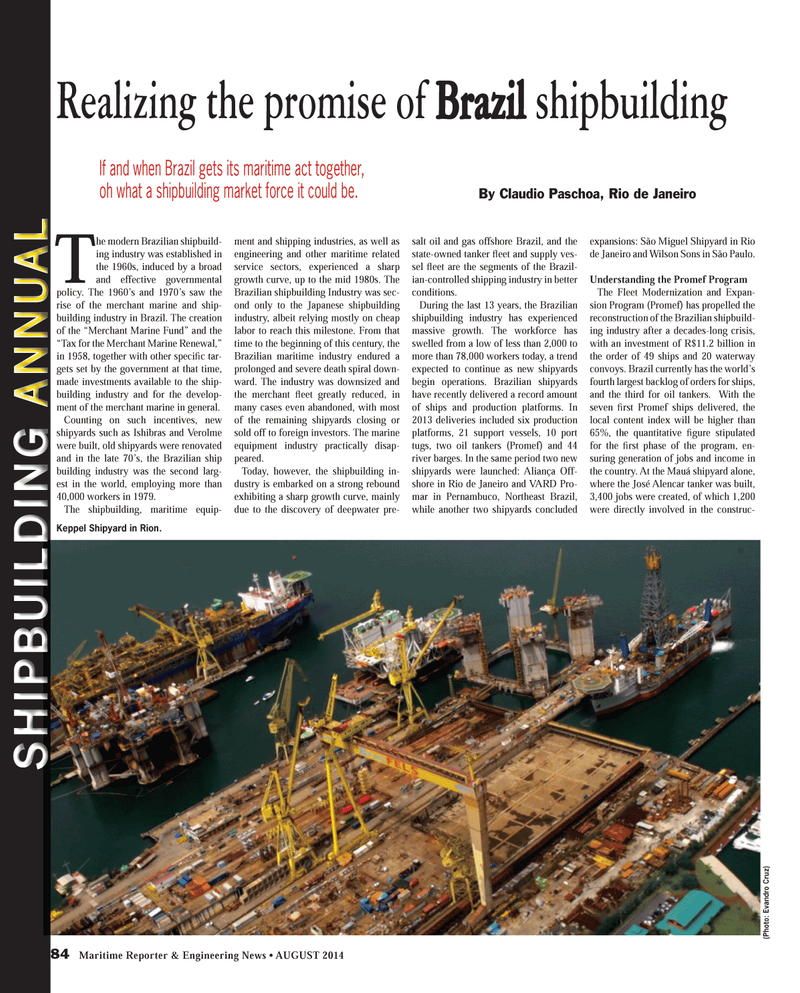
Page 84: of Maritime Reporter Magazine (August 2014)
Shipyard Edition
Read this page in Pdf, Flash or Html5 edition of August 2014 Maritime Reporter Magazine
84 Maritime Reporter & Engineering News ? AUGUST 2014 The modern Brazilian shipbuild-ing industry was established in the 1960s, induced by a broad and effective governmental policy. The 1960?s and 1970?s saw the rise of the merchant marine and ship-building industry in Brazil. The creation of the ?Merchant Marine Fund? and the ?Tax for the Merchant Marine Renewal,? in 1958, together with other speciÞ c tar- gets set by the government at that time, made investments available to the ship-building industry and for the develop-ment of the merchant marine in general. Counting on such incentives, new shipyards such as Ishibras and Verolme were built, old shipyards were renovated and in the late 70?s, the Brazilian ship building industry was the second larg- est in the world, employing more than 40,000 workers in 1979.The shipbuilding, maritime equip-ment and shipping industries, as well as engineering and other maritime related service sectors, experienced a sharp growth curve, up to the mid 1980s. The Brazilian shipbuilding Industry was sec-ond only to the Japanese shipbuilding industry, albeit relying mostly on cheap labor to reach this milestone. From that time to the beginning of this century, the Brazilian maritime industry endured a prolonged and severe death spiral down-ward. The industry was downsized and the merchant ß eet greatly reduced, in many cases even abandoned, with most of the remaining shipyards closing or sold off to foreign investors. The marine equipment industry practically disap-peared. Today, however, the shipbuilding in- dustry is embarked on a strong rebound exhibiting a sharp growth curve, mainly due to the discovery of deepwater pre-salt oil and gas offshore Brazil, and the state-owned tanker ß eet and supply ves-sel ß eet are the segments of the Brazil- ian-controlled shipping industry in better conditions. During the last 13 years, the Brazilian shipbuilding industry has experienced massive growth. The workforce has swelled from a low of less than 2,000 to more than 78,000 workers today, a trend expected to continue as new shipyards begin operations. Brazilian shipyards have recently delivered a record amount of ships and production platforms. In 2013 deliveries included six production platforms, 21 support vessels, 10 port tugs, two oil tankers (Promef) and 44 river barges. In the same period two new shipyards were launched: Aliança Off- shore in Rio de Janeiro and VARD Pro- mar in Pernambuco, Northeast Brazil, while another two shipyards concluded expansions: São Miguel Shipyard in Rio de Janeiro and Wilson Sons in São Paulo. Understanding the Promef Program The Fleet Modernization and Expan-sion Program (Promef) has propelled the reconstruction of the Brazilian shipbuild-ing industry after a decades-long crisis, with an investment of R$11.2 billion in the order of 49 ships and 20 waterway convoys. Brazil currently has the world?s fourth largest backlog of orders for ships, and the third for oil tankers. With the seven Þ rst Promef ships delivered, the local content index will be higher than 65%, the quantitative Þ gure stipulated for the Þ rst phase of the program, en- suring generation of jobs and income in the country. At the Mauá shipyard alone, where the José Alencar tanker was built, 3,400 jobs were created, of which 1,200 were directly involved in the construc-Realizing the promise of BrazilBrazil shipbuilding If and when Brazil gets its maritime act together, oh what a shipbuilding market force it could be. By Claudio Paschoa, Rio de Janeiro (Photo: Evandro Cruz) Keppel Shipyard in Rion. MR #8 (82-89).indd 84MR #8 (82-89).indd 848/5/2014 10:01:37 AM8/5/2014 10:01:37 AM

 83
83

 85
85
